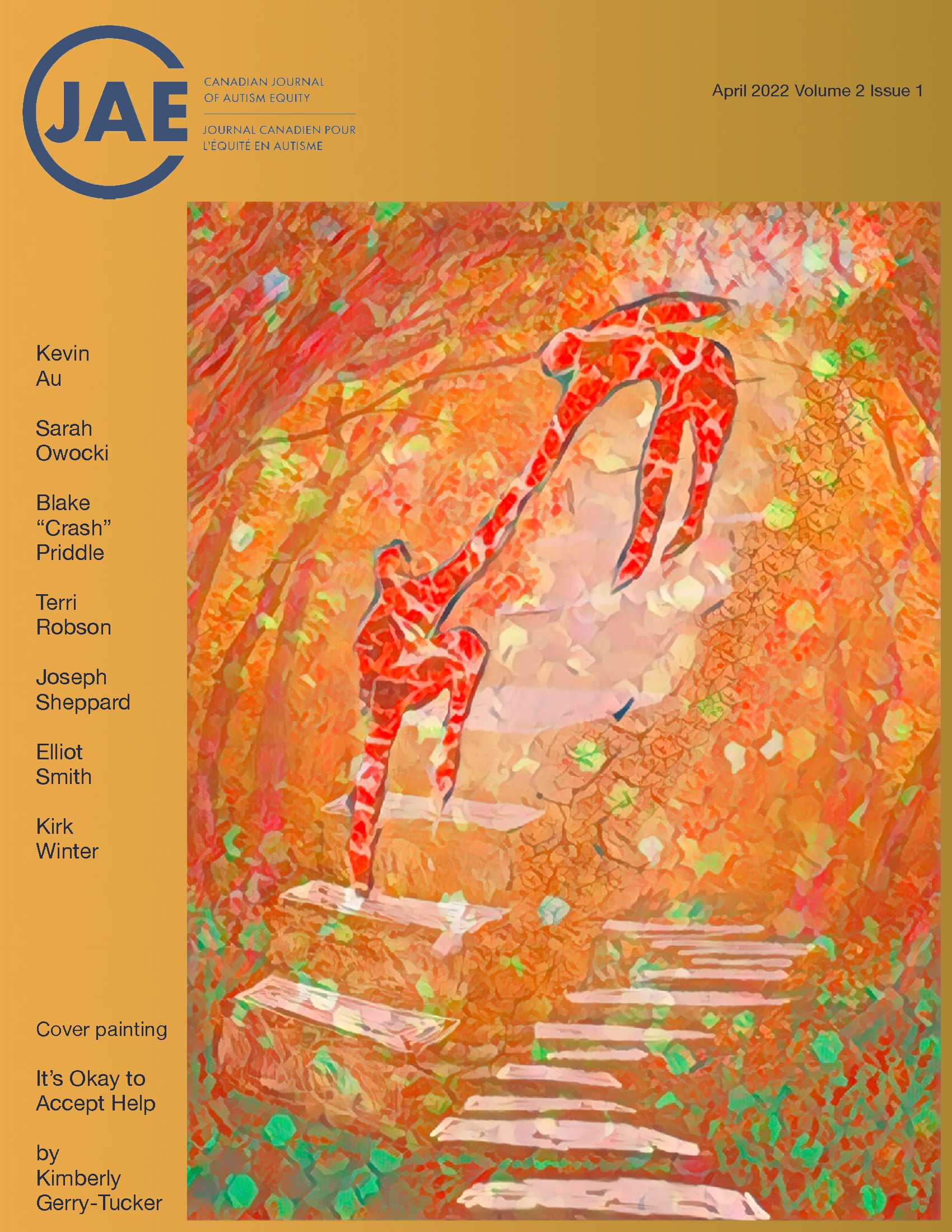Call for the Federal Public Service to create an initiative to recruit and hire employees with Autism:
How they can become more diverse, agile, and higher performing while improving staff retention rates and reducing staffing/training costs
DOI:
https://doi.org/10.15173/cjae.v2i1.4826Keywords:
Autism, Employment, Hiring, Initiative, Government of CanadaAbstract
Individuals with autism, a neurological condition impacting everyday activities, make up about 1.5-2.5% of the population. Compared to people with other disabilities, those with autism are disproportionately unemployed and underemployed. The Canadian federal government’s National Autism Strategy, consisting of research and funding to improve the health and well-being of those with autism, is led by the Public Health Authority of Canada (PHAC), but Employment and Social Development Canada (ESDC) plays an increasingly important role in supporting those on the spectrum through its programs and responsibility for implementing the Accessible Canada Act. ESDC, along with the Canada Revenue Agency (CRA) are two of the largest federal public sector employers. The writer, an autistic individual themself, advocates for ESDC and CRA to take the lead in creating a specialized hiring and retention process adapted to autistic individuals, as hiring and retaining autistic staff will likely produce a win-win result, helping the organizations become more diverse, higher performing and agile while reducing turnover and therefore staffing and training related costs.
References
Alton, L. (2019, August). Tech Companies Placing Increased Emphasis On Hiring Employees With Autism. Digitalist Magazine. https://www.digitalistmag.com/improving-lives/2019/08/15/tech-companies-placing-increased-emphasis-on-hiring-employees-with-autism-06200135/
Annabi, H., Crooks, E.W., Barnett, N., Guadagno, J., Mahoney, J.R., Michelle, J., Pacilio, A., Shukla, H. and Velasco, J. (2019). Autism @ Work Playbook: Finding talent and creating meaningful employment opportunities for people with autism. ACCESS-IT, The Information School, University of Washington. https://s3.amazonaws.com/disabilityin-bulk/2019/Autism_At_Work_Playbook_Final_02112019.pdf
Attwood, T. (2015) The Complete Guide to Asperger’s Syndrome. Jessica Kingley Publishers.
Baranger, A., Szilvasy Z., Friedel, E., Neerland, H., Wroniszewska, M., Schmit, C. EDS. (2014). Autism and Work: Together We Can: A report on good practices in employment for people with autism from across Europe. https://www.autismeurope.org/wp-content/uploads/2014/03/Report-on-autism-and-employment_EN.pdf
Bernick, M. (2021, January). The State Of Autism Employment In 2021. Forbes. https://www.forbes.com/sites/michaelbernick/2021/01/12/the-state-of-autism-employment-in-2021/
Centre for Interdisciplinary Research and Collaboration in Autism. (2021, April). Autism and Neurodiversity in the Workplace. https://circa.educ.ubc.ca/autism-in-the-workplace/
Employment and Social Development Canada. (2018). 2017–2018 Departmental Results Report.
Employment and Social Development Canada. (2019, August). Government of Canada announces appointments to the Canadian Accessibility Standards Development Organization. https://www.canada.ca/en/employment-social-development/news/2019/08/government-of-canada-announces-appointments-to-the-canadian-accessibility-standards-development-organization.html
Employment and Social Development Canada. (2020). ESDC Staffing Year End Report 2019-2020.
Hendricks, D. (2010). Employment and adults with autism spectrum disorders: Challenges and strategies for success, Journal of Vocational Rehabilitation, 32, pp.125–134. https://worksupport.com/documents/JVRautismHendricks.pdf
Ofner, M., Coles, A., Decou, M.L., Do, M.T., Bienek, A., Snider, J., and Ugnat, A. (2018, March). Autism Spectrum Disorder among Children and Youth in Canada 2018: A Report of the National Autism Spectrum Disorder Surveillance System. Public Health Agency of Canada. https://www.canada.ca/en/public-health/services/publications/diseases-conditions/autism-spectrum-disorder-children-youth-canada-2018.html
Public Health Agency of Canada. (2020, May). Autism Spectrum Disorder - Highlights from the Canadian Survey on Disability. https://www.canada.ca/en/public-health/services/publications/diseases-conditions/infographic-autism-spectrum-disorder-highlights-canadian-survey-disability.html
Public Health Agency of Canada. (2020, October). National Autism Strategy. https://www.canada.ca/en/public-health/services/diseases/autism-spectrum-disorder-asd/national-strategy.html
Public Service Commission. (2020, February). Annual Report 2018-19: Building tomorrow’s public service today. https://www.canada.ca/en/public-service-commission/services/publications/annual-report-2018-19.html
Public Service Commission. (2021, January). Audit of Employment Equity Representation in Recruitment. https://www.canada.ca/en/public-service-commission/services/publications/audit-of-employment-equity-representation-in-recruitment.html
Ready Willing Able. (2019, October). RWA Works: Building Inclusive Businesses Across the Country. https://drive.google.com/file/d/1zxETTVATxPWymRvoadCPrC8HXwssyHR8/view
Roux, A. M., Shattuck, P. T., Cooper, B. P., Anderson, K. A., Wagner, M., & Narendorf, S. C. (2013). Postsecondary employment experiences among young adults with an autism spectrum disorder. Journal of the American Academy of Child and Adolescent Psychiatry, 52(9), 931–939. https://doi.org/10.1016/j.jaac.2013.05.019
Scott M, Jacob A, Hendrie D, Parsons R, Girdler S, Falkmer T, et al. (2017) Employers’ perception of the costs and the benefits of hiring individuals with autism spectrum disorder in open employment in Australia. PLoS ONE 12(5): e0177607. https://doi.org/10.1371/journal.pone.0177607
Stainton, T., Hole, R., Crawford, C. (2018, January.) Ready, Willing and Able Initiative Evaluation Report. University of British Columbia Centre for Inclusion and Citizenship. https://cic.arts.ubc.ca/files/2019/05/Ready-Willing-and-Able-Evaluation-Final-Report-January-2018-1.pdf
Morris, S., Fawcett, G., Brisebois, L., Hughes, J. (2018, November). Canadian Survey on Disability, 2017. Statistics Canada.
https://www150.statcan.gc.ca/n1/daily-quotidien/181128/dq181128a-eng.htm
Treasury Board of Canada Secretariat. (2018, January). Building a Diverse and Inclusive Public Service: Final Report of the Joint Union/Management Task Force on Diversity and Inclusion. https://www.canada.ca/en/treasury-board-secretariat/corporate/reports/building-diverse-inclusive-public-service-final-report-joint-union-management-task-force-diversity-inclusion.html
Treasury Board of Canada Secretariat. (2020, August). Demographic Snapshot of Canada’s Public Service, 2019. https://www.canada.ca/en/treasury-board-secretariat/services/innovation/human-resources-statistics/demographic-snapshot-federal-public-service-2019.html
Treasury Board of Canada Secretariat. (2020, August). Population of the federal public service by department. https://www.canada.ca/en/treasury-board-secretariat/services/innovation/human-resources-statistics/population-federal-public-service-department.html
Treasury Board of Canada Secretariat. (2020, November). Distribution of public service of Canada employees by designated group and age range https://www.canada.ca/en/treasury-board-secretariat/services/innovation/human-resources-statistics/diversity-inclusion-statistics/distribution-public-service-canada-employees-designated-group-age-range.html
Treasury Board of Canada Secretariat. (2021, March). Employment: Accessibility Strategy for the Public Service of Canada. https://www.canada.ca/en/government/publicservice/wellness-inclusion-diversity-public-service/diversity-inclusion-public-service/accessibility-public-service/accessibility-strategy-public-service-toc/accessibility-strategy-public-service-employment.html
Downloads
Published
How to Cite
Issue
Section
License
Copyright (c) 2022 Kevin Au

This work is licensed under a Creative Commons Attribution-NonCommercial-ShareAlike 4.0 International License.
Authors retain copyright and grant the journal the right of first publication with the work simultaneously licensed under a Creative Commons Attribution License that allows others to share the work with an acknowledgement of the work's authorship and initial publication in this journal.
Authors are able to enter into separate, additional contractual arrangements for the non-exclusive distribution of the journal's published version of the work (e.g., post it to an institutional repository or publish it in a book), with an acknowledgement of its initial publication in this journal.
CJAE accepts articles that have not been published in any other journals/proceedings, unless copyright permission is assured, and have not been submitted for consideration to any other journals/proceedings at the time of submitting to the Canadian Journal of Autism Equity for consideration. While a paper is under consideration by CJAE, you agree not to submit the work to other journals/proceedings until review by CJAE is completed and a decision has been rendered.



